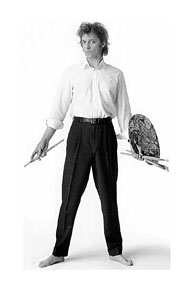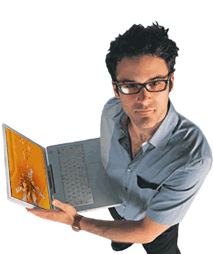How to choose a designer for the project and not to miscalculate?
Every time, thinking about a new project or starting to redesign an existing one, I try to connect a new designer to the work, although it would be easier to work with an already familiar one. I do this for two reasons:
- Firstly, a new designer is always a new look at things, this is a person with the help of whom I myself can take a slightly different look at what is planned to be implemented, as well as what has already been done.
secondly, it is an opportunity to get acquainted with a specialist and later work with him regularly, already knowing what result can be expected from him.
We must immediately make a reservation that, although the recommendations below are applicable to the search for different specialists, this article will deal with the search for a leading website designer , as they would say in the theater - the “production designer” of the project.
The “lead” reservation is needed because large designers, as a rule, involve several designers. A narrow specialist is involved for each front of work - one designer draws a logo, another creates vector images, a third conjures icons for the site ... interface planning, flash inserts, photo processing, etc. can be displayed in separate niches. And all this is brought together by that “leading designer” and it is he who creates the final visual structure of the site.
Where do designers come from?
So, a decision was made to start work on the project, the issue was resolved with programmers, editors, or who else we need, and the place of the lead designer of the project is still vacant. We start the search and find three alternatives. We can find a designer:
Experience has shown that good specialists who combine human responsibility and high professional qualities are extremely rare. But we still do not want to overpay. And not because of congenital avarice. It has just been proven long ago that exceeding the average pay rates for a given front of work does not guarantee an automatic increase in quality.
')
So, we are looking for a designer and have identified three nesting sites of these strange creatures. Consider them:
Recommendation of friends
The human factor of the designer, who came on the recommendation, the most predictable of the options under consideration. You can find out from recommending his friends information about a person's ability to get involved, about life and professional priorities, about character, etc. After all, the human qualities of this one of their main team members play an equally important role than their professional level.
The disadvantages of the “recommended” designer are that he can be a contact and agreeable person, but not a strong enough specialist, but the magic word “recommendation” sometimes blurs the eye and lack of knowledge, sometimes manifests too late.
Contact the design studio
It would seem - what is easier? Need a designer - call the design studio in your city and be happy! However, this, unfortunately, is not at all the case. As a rule, even the best design studios are organized and built to be a factory for the production of sites. Typically, this is a corporate web representation, whose structure is simple and uncomplicated.
The studio manager (if it is a good manager) will paint you in colors the “individual approach” and “non-template thinking” of their designers. But in 99 percent of cases it will be ... not quite. Everything will happen, as in a joke about a gourmet who gives the waiter a long time, how this time you need to make him a chop calf, indicating everything, right up to the exact age of the calf, the place where he grew up, the herbs that he ate, but the waiter assured the customer that everything will be just like that, comes to the kitchen and says to the cook: “Vasya, steak two times ...”. And what happened to these nuances, painstakingly outlined by the client? It all came down to a unified solution ...
The conclusion from here is that if you are doing some unusual project, going to the studio is almost a guarantee that you will get a formal steak (maybe of very good quality), instead of a truly unique solution and a non-trivial approach to the subject.
Self Search
And finally, the last option is to try to find the designer yourself. The forums and sites where you can post job ads are known and I will not list them. It is worth mentioning only that recently the effect of the publication of free ads on freelance sites is less. A free ad very quickly goes down, giving way to new projects of other employers, and not all those who might be interested in you have time to see it. Therefore, for large projects, I recommend buying a paid ad , which “sags” for several days on the main page, fixed at the top of the list and will be viewed by a much larger number of potentially interesting specialists.
In addition, we must not forget that a paid ad, clearly distinguished from a host of others, indicates to designers the seriousness of your intentions. What is also important.
In a word, in the choice of a designer, the surest, albeit the most troublesome way is an independent search and selection. True, this makes sense only if you are able to distinguish the work of a good designer from a bad one ... but if this is not the case, then you probably shouldn't read this article at all. It will not bring you practical benefits. I assume that, looking at the work presented in the portfolio of a specialist, you are able to make a conclusion about his professional viability. At least approximately ...
How to choose the best one?
Imagine that all the preliminary actions have been carried out, recommendations from friends have been received, announcements have been published and you have collected links to a couple of dozen portfolios of designers who have already become familiar with the project and are theoretically ready to start working with you. How to choose one?
In order to conduct a primary screening, considering the portfolio of applicants, we draw attention to:
As a result of dropping out “on a professional basis” there should be 2-6 applicants. They need to look more closely.
It is worth paying attention to age. He does not play a critical role and sometimes even misleading. But still, too young a designer is usually bad because of its unpredictability. And a man of an age is often quite wise in his views, which can also interfere with work. The optimal age for a designer, in my opinion, is 26-30 years old. By this time he manages to become a good specialist, but he still has not lost the ability to perceive something new, to experiment, to get involved.
Then, it is worth clarifying for yourself in which countries and cities the applicants live. The possibility of personal, and not just remote communication is a big plus. Yes, and the very place of residence of a person allows to draw some conclusions. It is one thing to communicate with a person from Moscow, and another from somewhere in a small town in the Far East. Neither is better or worse. Just communication will be built in different ways. And it needs to be understood.
Completing the study of the personalities of applicants, we go further. A great help is the fact that the designer has a personal blog or projects created “for himself”. This will allow to look at it from the human side. Who is he by nature? Snob? Whiner? Optimist? A lover of girls? .. All this makes it possible to draw a more complete picture. Imagine a person clearer.
And finally, the last thing I do before making a final decision, I spend preliminary conversations with applicants by ICQ, e-mail or phone. In these conversations, I seek to find out the motivation of a person. What, besides the desire to get money from me, moves him? Is there no danger in the process of work to stumble on narcissism and ambition in the spirit of "all idiots, one I know how to." How is the designer set up in relation to the project that he wants to have in the dry residue when the work will be completed? If there is no professional interest in the project - this is not the person ...
The question is - why is everything so difficult? Because it is human qualities that come to the fore in the process of work. Willingness to approach the project informally and lead it not by the time of final settlement, but to logical completion, the desire to do well “not out of fear, but out of conscience”, the ability to rise above their ambitions and admit a mistake, if such is made, etc.
It is important to understand that when choosing a lead designer, you choose a co-author of a project, a colleague whose personal and professional qualities will directly and indirectly affect the final result.
Original text - Spiridonov.ru (notes by web-producer)
Source: https://habr.com/ru/post/11052/
All Articles